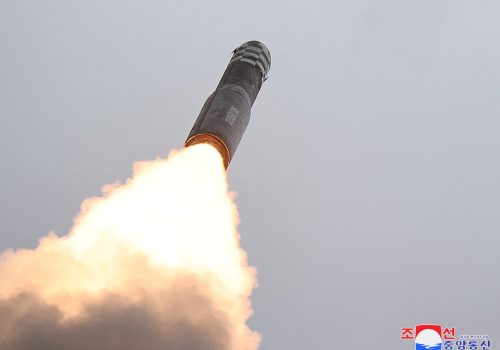There will be no ‘short, sharp’ war. A fight between the US and China would likely go on for years.
Everyone loves a short, sharp war. They end on time, are won decisively, and provide tight narrative completion for the stories we want to tell.
Among military commanders, planners, and theorists, this often manifests itself in the quest for the decisive battle—one that will inflict such a stunning defeat on the enemy that its will to fight is broken, forcing enemy leadership to sue for peace or otherwise accept terms of surrender. In naval warfare, Alfred Thayer Mahan embodied this ideal in his prescription to mass one’s superior fleet against an adversary’s inferior fleet, seek and win decisive battles, and thereby win command of the sea.
This bias is borne out in modern US war games, in which players command opposing armed forces in simulated warfare. Usually sponsored by military commands or think tanks, such games generally open with a compressed “road to war,” or a backstory and the conditions under which the notional war begins. The players—usually a mix of military officers, officials, policymakers, and think tankers—“fight” a highly kinetic scenario at the opening stage of a conflict. While a war game might theoretically play out over a longer period, time constraints in the real world typically compel game sponsors and facilitators to end these games in a short period, often in a few days or a little over a week. Conclusions are then made based off of the snapshot provided by this brief gameplay. The results inform commanders and policymakers as they approve war plans and military investments.
In the United States, war-game results might, for example, inform prioritization of weapons procurement by the Office of the Secretary of Defense or the enthusiasm for Congress to invest in security infrastructure across the Indo-Pacific. Recently, an unclassified Center for Strategic and International Studies war game played out a scenario in which the United States fought China and won—albeit at great cost. While informative, this game focused largely on a short, decisive fight in and around Taiwan and the first island chain.
Committing the preponderance of security studies to the first phases of a global war of attrition is short-sighted.
The same trend is borne out in the literary genre of “useful fiction.” Recent novels such as Ghost Fleet and White Sun War depict wars fought primarily between the United States and China. Almost always in such works, the war is brought to a satisfying conclusion over a relatively short time frame. In part, this is a function of the commercial format, which almost certainly inclines authors toward tidy endings to satisfy publishers and readers alike. But the novels’ popularity among military readers and their placement on official military service reading lists also reveal a predilection in the US military to think in terms of quick wars with decisive outcomes.
But wars between great powers are rarely short and sharp. They are more often long, grueling slogs of attrition that tend to expand horizontally, ensnaring other regions in their wake. Of course, it is possible that a US-China conflict over Taiwan could be an exception, that it could be brief and limited instead of protracted and wide-spread, but it’s irresponsible to assume such an outcome given history.
For the French and the British, the American Revolutionary War was but a single theater of war in what was then the latest episode of an enduring conflict that spanned the globe. At the outset of World War I, popular opinion in Britain, among other belligerents, held that the war would be “over by Christmas,” only for that nation and the world to endure four long years of slaughter. Imperial Japan launched its surprise attack on Pearl Harbor based on the assessment that it would convince the United States to cede to Japan its interests in the Pacific. Instead, Japan found itself fighting for years on the strategic defensive, until the atomic bombing of Hiroshima and Nagasaki forced Japan’s unconditional surrender.
Examples abound, but the historical record repeats this simple but critical theme: Great powers rarely settle military conflicts with other great powers in a neat, tidy fashion. Yet despite career requirements to attend professional schools where military history is at the heart of the curriculum, military planners continue to chase the unicorns of decisive battles and short wars. Cathal Nolan documents this phenomenon, and reveals its hollowness, in his masterful The Allure of Battle.
But if one were to write the novel that more precisely illustrates the long, global grind that a war between the United States and China would entail, it might appear something like this:
The opening pages showcase the trends of modern war games and novels, where naval combatants, fifth-generation aircraft, missile forces, and non-kinetic effects wreak havoc in the war’s opening days, crippling the air and naval power of the belligerents. Thousands upon thousands are killed in this first stage of the conflict. But the war expands horizontally, with China, Russia, and North Korea aligned against the United States, Taiwan, Japan, the Philippines, Australia, South Korea, and others. Fighting occurs in multiple theaters within United States Indo-Pacific Command and beyond, including a massive conflagration on the Korean peninsula. Soon, the ability to hurl precision munitions back and forth culminates as expenditure rapidly outpaces production capacity and as US fuel stocks in the Pacific dwindle. With pressure increasing and options decreasing, tactical nuclear weapons are employed on the battlefield . . . and yet the war drives on.
Thus would end the first chapter. The reader turns the page, which says: “Three years later.”
And with some skillfully placed exposition, the author reveals the massive changes that have occurred across society as belligerents commit to a long, bloody war. Nations have fully mobilized their economies to support what is now an existential war. Drafts and conscription are made mandatory to fill and maintain the ranks of multiple field armies, amphibious corps, fleets, and air forces. The war is not limited to the first island chain, but has multiple theaters that span the globe and escalates horizontally, with simultaneous conflicts drawing in additional belligerents. Emergency powers are universally invoked by executive branches, curtailing liberties in even the historically freest societies. The threat of nuclear holocaust is ever-present, and continuous fighting through tactical nuclear exchanges shatters previous conceptions of escalation management.
While these are logical conclusions should a US-China war occur, they usually take a backseat in policy analysis, strategic thinking, and operational planning, eclipsed again and again by a hyperfocus on a limited conflict in and around Taiwan. Committing the preponderance of security studies to the first phases of a global war of attrition is short-sighted, like a chess player who studies openings but fails to study the mid-game or its closing. None of this is easy, of course. Large-scale war disrupts societies and technology in profound and often unexpected ways. But because of this feature and not in spite of it, US policymakers and military leaders must rigorously study and plan for a broad range of implications of a years-long war with China.
Lieutenant Colonel Brian Kerg is a nonresident fellow in the Indo-Pacific Security Initiative at the Atlantic Council’s Scowcroft Center for Strategy and Security. Kerg is an active-duty US Marine Corps operational planner currently assigned as the G-5 director of plans, III Marine Expeditionary Force.
The views expressed here are those of the author and do not represent the positions or opinions of the US Marine Corps, the Department of Defense, or any part of the US government.
Further reading
Sat, Jan 13, 2024
The sentencing of a US Navy sailor is a window into Chinese espionage. Here’s how the US should respond.
New Atlanticist By Andrew Brown
China’s intelligence services recognize that national security information does not have to be classified to provide them with value.
Thu, Feb 29, 2024
China has become an electric vehicle export behemoth. How should the US and EU respond?
New Atlanticist By Joseph Webster
The United States and European countries need to better understand the security risks sensor-laden electric vehicles from China could pose.
Wed, Aug 16, 2023
The United States and its allies must be ready to deter a two-front war and nuclear attacks in East Asia
Report By Markus Garlauskas
This report highlights two emerging and interrelated deterrence challenges in East Asia with grave risks to US national security: 1) Horizontal escalation of a conflict with China or North Korea into simultaneous conflict; 2) Vertical escalation to a limited nuclear attack by either or both adversaries to avoid conceding.
Image: New recruits of Chinese People's Liberation Army (PLA) attend a send-off ceremony at a railway station in Ganzhou, Jiangxi province, China, March 16, 2023.


